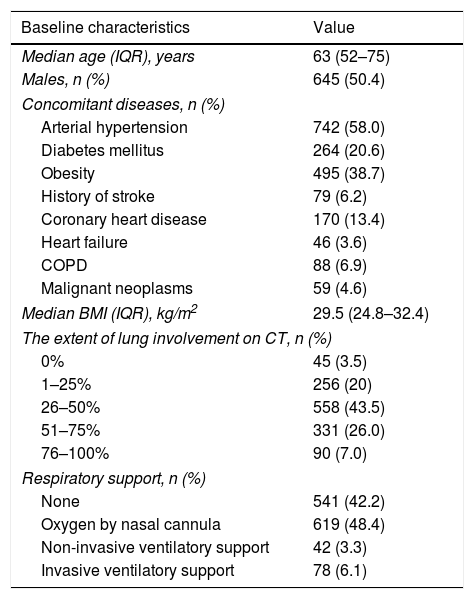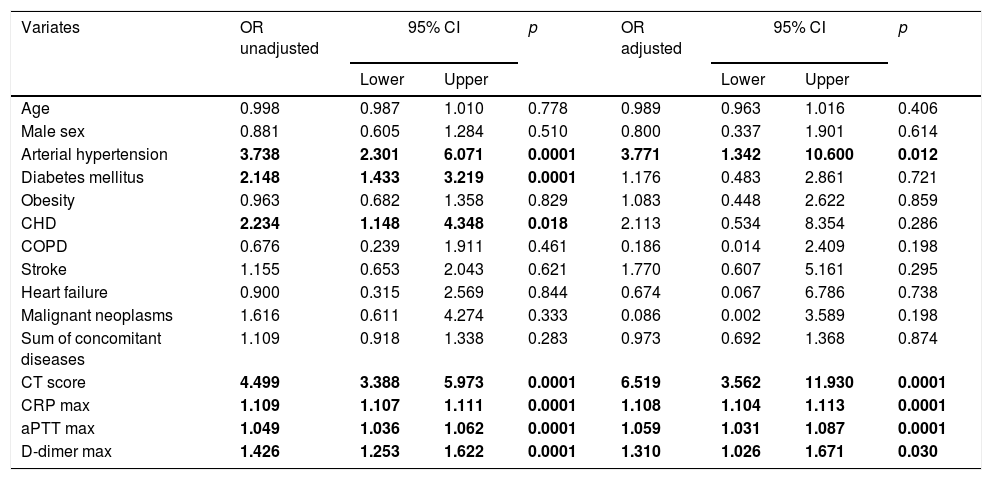The mortality rates in patients with COVID-19 pneumonia depend largely on the need to start oxygen supply and the level of respiratory support. In a nationwide study of 1522 consecutive patients with COVID-19 admitted to the Russian intensive care units, the mortality rate was low in patients requiring oxygen supply only (10.1%) and significantly higher in patients who required non-invasive (36.8%) or invasive (76.5%) ventilation.1 Recently, P. Ramírez et al.2 published data on ARDS patients admitted to a medical critical care unit (MCCU) and showed the lower mortality (23.5%).
The aim of our retrospective study was to investigate the risk factors for NI/I-VS and mortality in 1268 hospitalized patients (638 males and 630 females; median age 63 [52–75] years) with COVID-19 who had completed their hospital stay (death or recovery) from April to June 2020. A diagnosis of COVID-19 was confirmed by polymerase chain reaction on nasopharyngeal swab and/or chest CT (4 or 5 on CO-RADS scale). The extent of lung involvement on CT was classified as none (0%), minimal (1–25%), mild (26–50%), moderate (51–75%), or severe (76–100%) (Table 1).
Clinical and demographic characteristics of 1268 hospitalised patients with COVID-19.
| Baseline characteristics | Value |
|---|---|
| Median age (IQR), years | 63 (52–75) |
| Males, n (%) | 645 (50.4) |
| Concomitant diseases, n (%) | |
| Arterial hypertension | 742 (58.0) |
| Diabetes mellitus | 264 (20.6) |
| Obesity | 495 (38.7) |
| History of stroke | 79 (6.2) |
| Coronary heart disease | 170 (13.4) |
| Heart failure | 46 (3.6) |
| COPD | 88 (6.9) |
| Malignant neoplasms | 59 (4.6) |
| Median BMI (IQR), kg/m2 | 29.5 (24.8–32.4) |
| The extent of lung involvement on CT, n (%) | |
| 0% | 45 (3.5) |
| 1–25% | 256 (20) |
| 26–50% | 558 (43.5) |
| 51–75% | 331 (26.0) |
| 76–100% | 90 (7.0) |
| Respiratory support, n (%) | |
| None | 541 (42.2) |
| Oxygen by nasal cannula | 619 (48.4) |
| Non-invasive ventilatory support | 42 (3.3) |
| Invasive ventilatory support | 78 (6.1) |
IQR: interquartile range; BMI: body mass index.
A total of 731 (57.6%) of 1268 patients required supplemental oxygen. Most of them received oxygen therapy via nasal cannulas, whereas NI/I-VS was started in 119 (9.4%) patients (Table 1). Among patients on NI/I-VS, the mortality rate was significantly higher than among patients who did not require oxygen therapy or were treated with oxygen via nasal cannulas (59.7% and 7.9%, respectively, OR 29.004 [19.71–42.68], p<0.001). In univariate logistic model, the following factors were associated with the requirement for NI/I-VS: the maximum CRP and D-dimer levels, prolonged APTT, the extent of bilateral lung involvement, arterial hypertension, coronary heart disease, and diabetes mellitus. Among them, CRP, aPTT, D-dimer, the extent of lung involvement, and arterial hypertension retained statistical significance in multivariate logistic regression model (Table 2).
Logistic regression model of NI/I-VS risk in COVID-19 patients.
| Variates | OR unadjusted | 95% CI | p | OR adjusted | 95% CI | p | ||
|---|---|---|---|---|---|---|---|---|
| Lower | Upper | Lower | Upper | |||||
| Age | 0.998 | 0.987 | 1.010 | 0.778 | 0.989 | 0.963 | 1.016 | 0.406 |
| Male sex | 0.881 | 0.605 | 1.284 | 0.510 | 0.800 | 0.337 | 1.901 | 0.614 |
| Arterial hypertension | 3.738 | 2.301 | 6.071 | 0.0001 | 3.771 | 1.342 | 10.600 | 0.012 |
| Diabetes mellitus | 2.148 | 1.433 | 3.219 | 0.0001 | 1.176 | 0.483 | 2.861 | 0.721 |
| Obesity | 0.963 | 0.682 | 1.358 | 0.829 | 1.083 | 0.448 | 2.622 | 0.859 |
| CHD | 2.234 | 1.148 | 4.348 | 0.018 | 2.113 | 0.534 | 8.354 | 0.286 |
| COPD | 0.676 | 0.239 | 1.911 | 0.461 | 0.186 | 0.014 | 2.409 | 0.198 |
| Stroke | 1.155 | 0.653 | 2.043 | 0.621 | 1.770 | 0.607 | 5.161 | 0.295 |
| Heart failure | 0.900 | 0.315 | 2.569 | 0.844 | 0.674 | 0.067 | 6.786 | 0.738 |
| Malignant neoplasms | 1.616 | 0.611 | 4.274 | 0.333 | 0.086 | 0.002 | 3.589 | 0.198 |
| Sum of concomitant diseases | 1.109 | 0.918 | 1.338 | 0.283 | 0.973 | 0.692 | 1.368 | 0.874 |
| CT score | 4.499 | 3.388 | 5.973 | 0.0001 | 6.519 | 3.562 | 11.930 | 0.0001 |
| CRP max | 1.109 | 1.107 | 1.111 | 0.0001 | 1.108 | 1.104 | 1.113 | 0.0001 |
| aPTT max | 1.049 | 1.036 | 1.062 | 0.0001 | 1.059 | 1.031 | 1.087 | 0.0001 |
| D-dimer max | 1.426 | 1.253 | 1.622 | 0.0001 | 1.310 | 1.026 | 1.671 | 0.030 |
Multivariate model was adjusted for age, sex, maximum aPTT, CRP, ferritin, D-dimer, lactate dehydrogenase levels, CT score, presence and absence of diabetes mellitus and arterial hypertension, obesity, coronary heart disease, stroke, chronic obstructive pulmonary disease, heart failure, malignant neoplasms, sum of underlying diseases in the logistic regression model.
aPTT: activated partial thromboplastin time; CHD: coronary heart disease; CRP: C-reactive protein; CT: computer tomography; COPD: chronic obstructive pulmonary disease.
Our findings showed that the need in NI/I-VS was associated with a seven-fold increase in the mortality rates in the large cohort of the consecutive hospitalized patients with COVID-19. The lower mortality in work Ramírez et al.2 might be explained by therapy with steroids and tocilizumab in almost all patients (95.5%).
Lung pathology in COVID-19 shows extensive alveolar and interstitial inflammation and microvascular thrombosis. Infection, coagulation factors and innate immune effector systems (macrophages, neutrophils and the complement system) interact in a process termed immunothrombosis (or thromboinflammation), which is the convergence of thrombosis and inflammation.3 The role of increased levels of inflammatory markers as well as D-dimer in the development of acute respiratory distress syndrome confirms this concept.4,5
In conclusion, systemic inflammatory response and coagulation disorders, as well as arterial hypertension were associated with the requirement for NI/I-VS in hospitalized COVID-19 patients.
Ethical approvalThe study was approved by the local ethics committee of the Zhadkevich City Clinical Hospital, Moscow (approval certificate no. 07-20).
FundingNone declared.
Conflict of interestThe authors do not have any conflicts of interest to declare.






